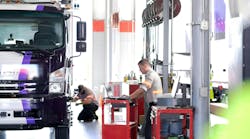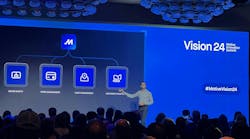Three indicators of the trucking industry's future appeared almost simultaneously in early February — from a nonprofit group, the White House, and the Census Bureau. Taken together, these omens suggest the future for trucking will be very different from the high-growth, high-productivity era of the 1990s. Revenue growth will be hard to come by, but cost increases will be hard to avoid, and worsening congestion will be inevitable.
Start with America's Rolling Warehouses, a report from The Road Information Program (www.tripnet.org). TRIP is a business-supported, nonprofit organization that researches, evaluates, and distributes economic and technical data on highway transportation issues.
Drawing on a variety of government and outside sources, TRIP points out that commercial truck travel in the U.S. is increasing faster than all other vehicle travel. Using FHWA's “Freight Analysis Framework,” TRIP estimates that the total tonnage shipped by trucks will grow 49% between 2003 and 2020.
That ought to be good news for carriers. But congestion threatens to spoil the party. TRIP cites an FHWA estimate that 46% of major highways in urban areas will be congested during peak periods by 2020, up from 28% in 1998.
“A comprehensive 2002 report from the Transportation Research Board concludes that worsening traffic congestion will likely reduce the efficiency and competitiveness of some U.S. businesses,” TRIP writes. “The report also found that some U.S. businesses are expected to respond to increasing congestion by moving some facilities to less-congested parts of the U.S. or to other countries.” And an FHWA report a year ago, not cited by TRIP, estimated that a substantial increase in federal and state spending would be needed to prevent worsening congestion and pavement conditions.
Such stark projections should galvanize Congress and the President into enacting a highway bill that would increase road capacity and keep congestion from turning into congealment. But just before the TRIP report came out, the President unveiled his fiscal-2005 budget, which calls for flat levels of highway spending right through 2009 — meaning a decrease after taking inflation into account.
The third indication came from the Census Bureau's 2002 Service Annual Survey on truck transportation (www.census.gov). That report showed that for-hire trucking revenues totaled $198 billion in 2002, little changed from 2001. Long-distance general-freight carrier revenue rose 2% but specialized-freight trucking revenues fell 7%.
Since 2002, the volume of freight has grown as the pace of economic activity picked up. However, many trucking costs, notably fuel and insurance, have risen even faster. The recent changes in hours-of-service rules will impose even steeper costs on many carriers, particularly if more drivers exhaust their available hours stuck in congestion.
The bottom line: The era is over in which carriers could try to chase volume in the hopes of growing their way into prosperity. The return of faster economic growth does not imply that the volume of freight will grow proportionately. Growth is coming less from goods than from services, and more of the goods now come from abroad. Worse, congestion also will be growing faster than freight traffic, making each truck movement more expensive. Carriers must adapt by limiting their capacity and using it for higher-value shipments, or they'll find they have a lot of half-empty trucks stuck on very full roads.


